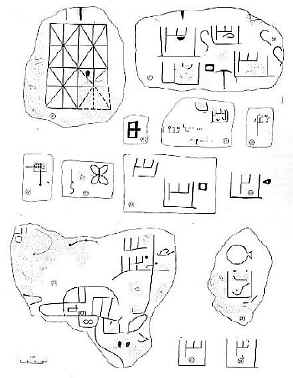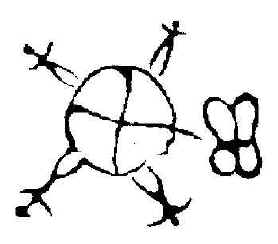The
earliest signs of mankind in Armenia were uncovered in the Hrazdan gorge,
near Bjini. The skeletal remains and stone tools have been variously
dated from between 1 to 2 million years ago.
The oldest 'town' in Armenia is a 90,000 BC Stone Age settlement found on the shoresof Lake Yerevan. From there through the Paleolithic period, proof of human settlement is scattered between cave dwellings and stone inscriptions on the Geghama Mountain Range. Suddenly, at the end of the Mesolithic period (between 9000-7000 BC), a complex web of cities and fortified settlements appeared throughout the Ararat valley. Only handfuls of which have been excavated, but enough to show a startlingly developed culture that rivaled those int he Mesopotamian Fertile Crescent.
Armenia’s ‘Fertile Crescent’ was located in two places: at the headwaters of the Euphrates and Tigris, and along the Arax River, its tributaries a series of liquid ribs branching off a central Ararat spine. Within the Ararat valley lies a smaller crescent of land, still bearing the marks of vast marshlands and forests that once covered the entire valley floor. As you wander through this area, you can spot sudden eruptions of the terrain, hills that seem to appear from nowhere. They do not ‘fit’ the contour of the land. These are the remains of the first urban civilization to leave its imprint on the ancient Armenian world: they are the sentinels of the Metsamor and Nairi Kingdoms, 'Armenia's Cradle of Civilization’.
Between 9000 and 5000 BC, cities appeared at evenly placed spots in this crescent, all of them built around the metal industry. The inhabitants were the first known to forge copper and bronze; and are the first recorded to successfully smelt iron. The metal ore mined in this area was among of the purest in the world, and its effect on urban life was tremendous.
 The
successful smelting of copper and bronze (as early as 5000 BC in Armenia),
along with gold, silver and magnesium, plus the mining of precious gems transformed
an agrarian civilization into to an urban one. The first signs of fortified
cities in Armenia are traced to this era, beginning with the excavation at
Metsamor (a thriving city by at least 5,000 BC, conjectured to be as old as
9,000 BC in its first incarnation). Other 5th millennium cities
include Dari Blur (Armavir), Aratashen Blur, AdaBlur and Teghut.
The
successful smelting of copper and bronze (as early as 5000 BC in Armenia),
along with gold, silver and magnesium, plus the mining of precious gems transformed
an agrarian civilization into to an urban one. The first signs of fortified
cities in Armenia are traced to this era, beginning with the excavation at
Metsamor (a thriving city by at least 5,000 BC, conjectured to be as old as
9,000 BC in its first incarnation). Other 5th millennium cities
include Dari Blur (Armavir), Aratashen Blur, AdaBlur and Teghut.
In the 4th millennium BC the cyclopic walls of Lechashen had been erected by Lake Sevan, while in the Ararat valley cities at Shengavit, Aigevan and Aigeshat were established. By 3000 BC a large kingdom was established around Metsamor with additional cities at MokhraBlur, Jerahovit, Lejapi Blur, Kosh and Voski Blur (Voski means "golden" in Armenian).
Inhabitants believed the technique for forging metal was given to them from the gods, and their temples combined metal idols with sophisticated stone observatories that charted the night sky. The first recorded astronomers, they were the earliest to create a calendar that divided the year into 12 segments of time, among the first to devise the compass, and to envision the shape of the world as round.
 Ancestral
Armenians developed a trading culture at a very early time. To do that, they
needed to understand and create a system of navigation. Longitude, latitude,
distance and direction had to be calculated for any trip farther than across
a few mountains. Artifacts uncovered at Metsamor come from as far-flung cultures
as those in Central Asia, Mesopotamia, the Black and Mediterranean Seas.
Others include navigational tools, inscribed in stone and accurately mapping
the night sky. In Sissian, a 4200 BC astral observatory built from stone
shows an incredibly sophisticated knowledge of the universe 2000 years before
the Babylonians—originally thought the first astronomers—had built their first
city.
Ancestral
Armenians developed a trading culture at a very early time. To do that, they
needed to understand and create a system of navigation. Longitude, latitude,
distance and direction had to be calculated for any trip farther than across
a few mountains. Artifacts uncovered at Metsamor come from as far-flung cultures
as those in Central Asia, Mesopotamia, the Black and Mediterranean Seas.
Others include navigational tools, inscribed in stone and accurately mapping
the night sky. In Sissian, a 4200 BC astral observatory built from stone
shows an incredibly sophisticated knowledge of the universe 2000 years before
the Babylonians—originally thought the first astronomers—had built their first
city.
Shengavit is distinct among the cities in Armenia for its use of round shaped dwellings made from river stones and mud brick. The artifacts found at Shengavit (ca. 5000-3000 BC) include black-varnished, red and gray pottery, in geometric patterns similar to those used in the Minoan culture.
Rapid development and unification through trading between the tribes in the Armenian plateau created a rich and prosperous culture that was to last for more than 5000 years. The metal based cultures that sprung up on the Armenian plateau were neighbors with Sumeria, Elam, and the first empire Akkad. They had mapped the constellations before the great pyramids were built, while Greece wasn’t even a thought, and the first dynasty in China was about 2000 years away.